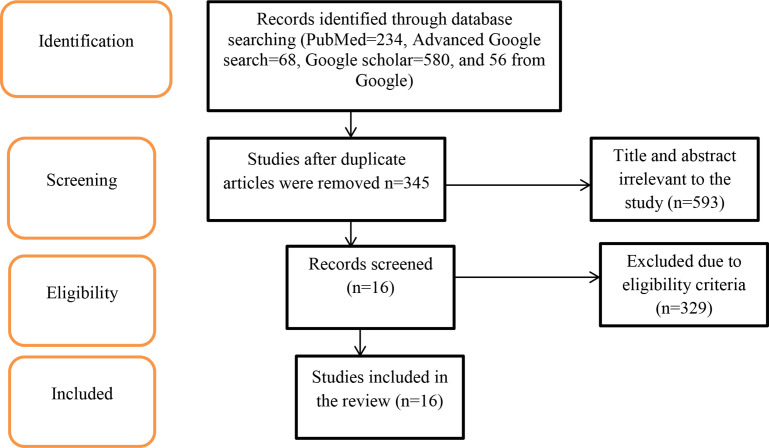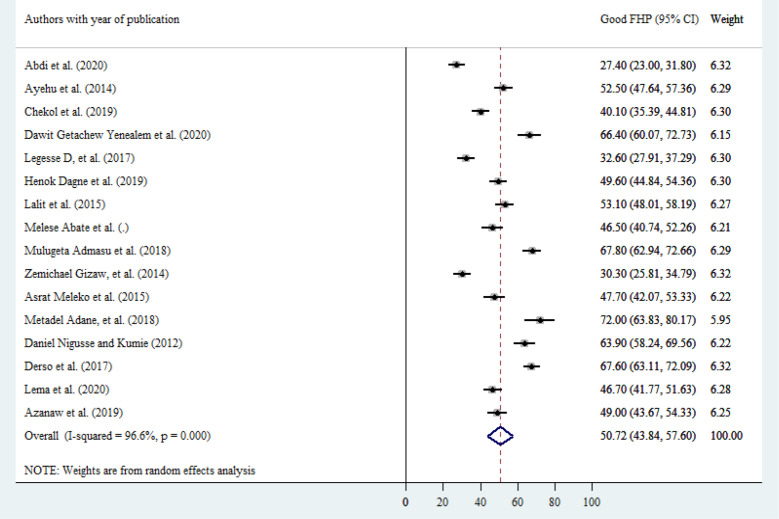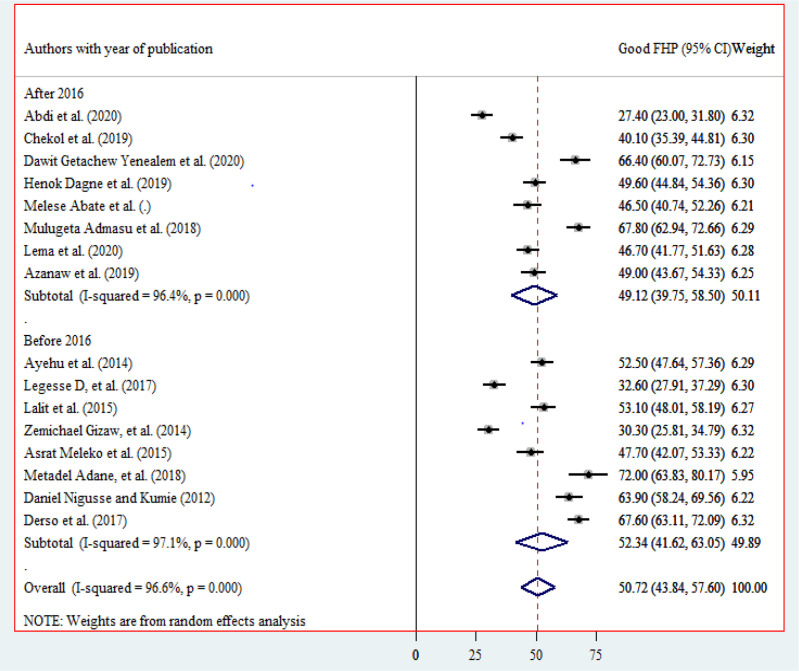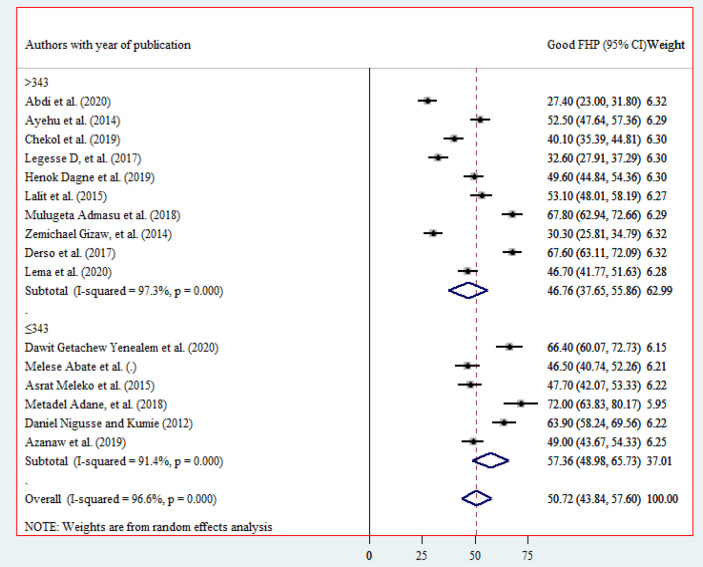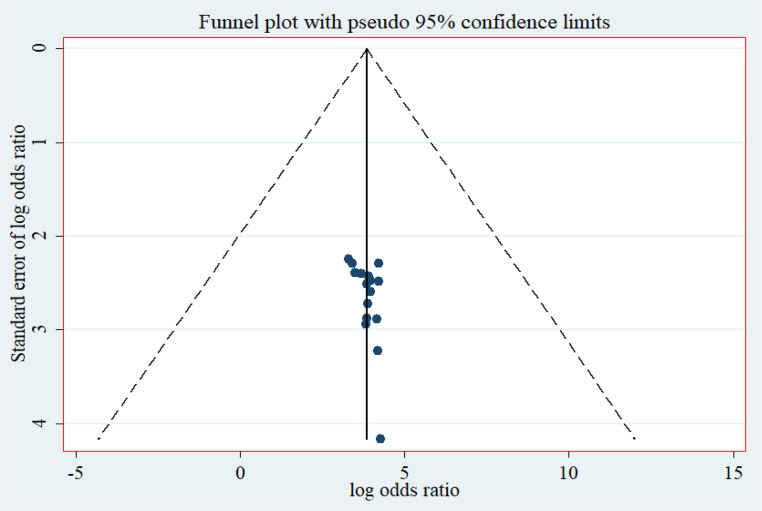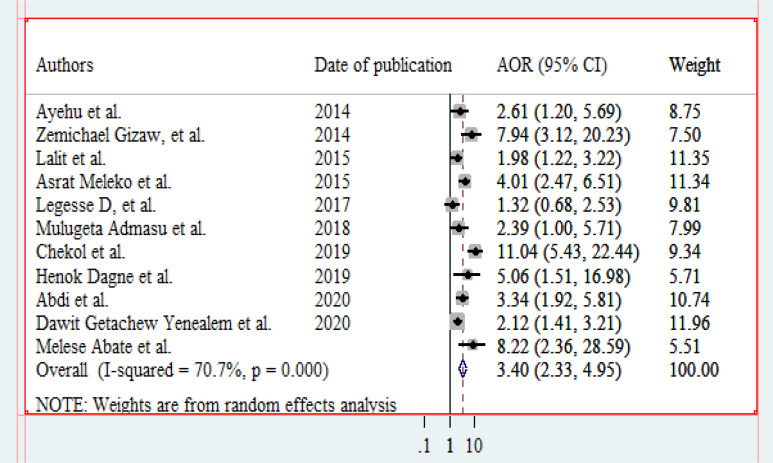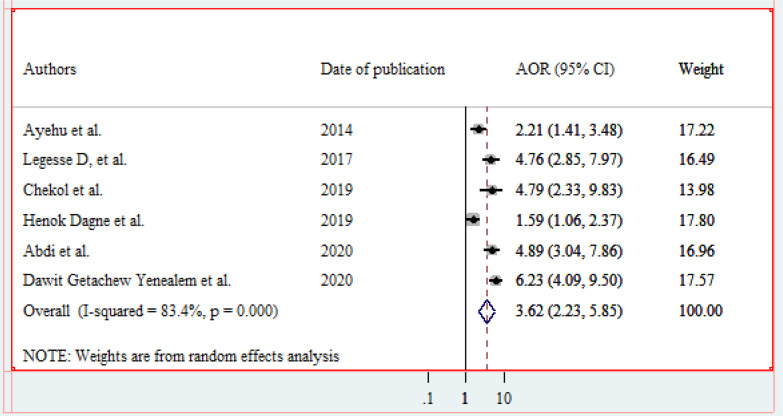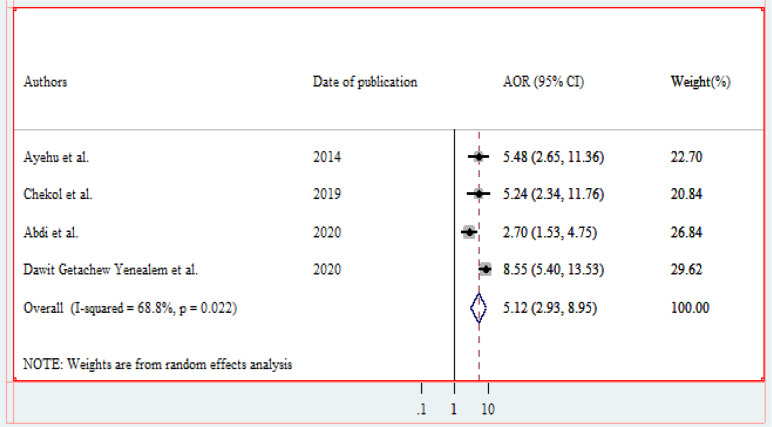Abstract
Objectives
Food handlers are individuals who are involved in food preparation, storage or service of food in a food facility. Unless they keep their personal hygiene, they are highly responsible for contaminating food or transmitting microbes to consumers. Thus, the main aim of this review was to pool the level of good food handling practice among food handlers working in public food establishments in Ethiopia.
Design
A systematic review and meta-analysis using the Joanna Briggs Institute (JBI) Critical Appraisal tool.
Data sources
PubMed, Google Scholar and Advanced Google were searched up to the end of February 2021.
Eligibility criteria for selecting studies
Publication status, publication language, type of study participants and the type of article were used to screen the article.
Data extraction and study quality assessment
All reviewers collected data independently and merged them together. A tool called the JBI Meta-Analysis of Statistics Assessment and Review Instrument was used to assess the quality of each research article. The assessment was performed by two reviewers.
Result
A total of 16 research articles were included in the review. The pooled level of good food handling practice was 50.72% with 95% CI (43.84% to 57.6%). Training (adjusted OR (AOR)=3.4, 95% CI (2.33 to 4.95)), attitude (AOR=3.62, 95% CI (2.23 to 5.85)) and medical check-up (AOR=5.12, 95% CI (2.93 to 8.95)) were identified as factors affecting good food handling practice with 95% CI at p<0.05.
Conclusion
The level of good food handling practice among food handlers working in public food establishments of Ethiopia was very low compared with literature, and variables such as food handler training, attitude towards good food handling practice and the existence of regular medical check-ups were factors affecting good food handling practice. Provision of training that could change the attitude and regular medical check-ups for food handlers has to be in place.
Keywords: Ethiopia, Food handlers, Food handling, Public food establishment
Strengths and limitations of this study.
The investigators of this review were doing their best to include all available shreds of evidence regarding the issue under review but still, there might be works of literature that were not published and hung on by authors.
Though the investigators also did their best to include articles of all study designs, still the available literature was obtained only with cross-sectional design and this might still have its influence on the quality of the review.
A little bit different operational definitions were used to define good food handling practice by authors of individual articles, therefore, this might have its implication on the generalisability of the findings.
Introduction
Ethiopian Public Health Proclamation No. 200/2000 defined food as any substance, whether processed, semiprocessed or raw, which is intended for human consumption and includes drinks, chewing gum, and any substance which has been used in the manufacture, preparation, or treatment of food, but it does not include tobacco, cosmetics or substances used only as drugs.1
Experts in different national and international organisations believed that food has to be promoted as part of essential components of primary healthcare.2 The food that we eat should be safe for consumption and should not endanger the health of the consumer via contamination or intoxication. Moreover, it should be available in sufficient quantity with adequate nutritional content.2 The food is wholesome and safe for consumption implies that the food we are going to eat has to be free of microbiological or chemical contamination that could bring ill-health.3 4
Many stakeholders can be involved in bringing food to the dining table including producers, harvesters, shippers, processors, distributors, handlers and others.5 Usually, food handlers are individuals who are involved in food preparation, storage or service of food in a food facility. Unless they keep their personal hygiene, they are highly responsible for contaminating food there by exposing it to foodborne diseases. Foodborne disease (also referred to as foodborne illness or food poisoning) is any illness that results from the consumption of contaminated food, contaminated with pathogenic bacteria, viruses or parasites; therefore, maintaining good food handling practice by food handlers is very essential.6 A food handler is defined as anyone who handles packaged or unpackaged food directly as well as the equipment and utensils used to prepare or serve food and/or surfaces that come into contact with food.7 According to Ethiopian public health law proclamation, every food handler working in a food establishment should have a medical check-up at least once in every 3 months.1
Research findings abroad indicated the level of food handling practice among food handlers was from very low (59.3%) to high (90%) (Indonesia, 90%8; Saudi Arabia, 80.29%9; Malaysia, 59.3%10; Jordan, 89.43%11; Nigeria, 78.2%12). Similarly, good food handling practice among food handlers in Ethiopia also ranged from a very low 27.4% in Addis Ababa to 72% in Dessie.13–28
Researchers, policymakers and other stakeholders need research evidence for making decisions. However, the shreds of evidence available are inconsistent, ranging from 27.4%13 in Addis Ababa to 72% in Dessie,28 which would challenge the users of the evidence to make the best choice from the available evidence. Moreover, in the research articles included in the review,13–28 the highest magnitude of good food handling practice was obtained from the small sample size,28 while the smallest effect size was obtained from a relatively large sample size.13 Hence, a systematic review and meta-analysis is needed to overcome the limitations of small sample sizes and evaluate effects in different subsets of participants. Therefore, the main aim of this review is to pool the level of good food handling practice among food handlers working in public food establishments in Ethiopia.
Methods
Protocol and registration
Usually, researchers are advised to maintain prior registration of their systematic review and meta-analysis in organisations like PROSPERO (http://www.crd.york.ac.uk/PROSPERO/), which could make the process transparent and hence reduces duplication of efforts.29 Therefore, this review has been registered at PROSPERO with registration identification number CRD42020223348.
Literature search
In this review, the step-by-step guide for conducting a systematic review and meta-analysis30 was used. A preliminary search was done to see the existence of a similar article thereby reducing duplication of efforts. Individual articles were searched up to the end of February 2021 from databases such as PubMed, Google Scholar and Advanced Google Search using keywords and medical subject headings (‘‘Food’’, ‘‘Handling’’, ‘‘Practice’’, ‘‘Handlers’’ and ‘‘Ethiopia’’). After having individual research articles, the title and abstract were screened. The protocol has been written and approved by each member and registered to PROSPERO.
Study selection
Selection of studies was done through removing duplicate studies, selecting researches that meet the inclusion/exclusion criteria based on the abstracts, and then making the final selection of studies based on their full text. The eligible articles for the review were selected independently by each reviewer and brought together for ensuring the consistency of our search. Differences between two investigators (AD and DA) regarding a single research article have happened and the third investigator (MTM) brought the issue for discussion and finally, all of the reviewers agreed to include the article after a big debate moderated by the third investigator.
Eligibility criteria
Publication status, publication language, type of study participants and the type of article were used to screen the article. Moreover, title and full-text downloading were also used to screen the eligible article as well. Therefore, this review included both published and unpublished original articles written in English, which were conducted from 2010 to the end of February 2021 among food handlers working in public food establishments in Ethiopia. However, this review excluded articles (n=329 out of 345) losing originality (an article is considered original research if it is the report of a study written by the researchers who actually did the study), local or governmental reports, conference abstracts and articles that were very difficult to access the full text.
Definition of terms
All of the articles included in this review thought that good food handling practice is the practice of maintaining a high degree of personal cleanliness, wearing clean outer garments and effective hair restraints, and refraining from smoking, eating, and drinking in the food preparation and service areas. In addition, a favourable attitude is the positive feeling that food handlers want to practice during food preparation, storage and transportation.13–28
Patient and public involvement
No patient involved.
Data extraction and study quality assessment
After collecting eligible individual research articles using criteria described under the heading ‘eligibility criteria’, variables (study region, study setting, study year, publication status, publication year, sample size, study design and sampling technique) more frequently used by individual research articles were collected as data. The collection of these data was performed independently by all reviewers and finally merged after reconciling disagreements created during data extraction.
A tool called Joanna Briggs Institute (JBI) Meta-Analysis of Statistics Assessment and Review Instrument adapted for both cross-sectional/case–control study designs31 was used to assess the quality of each research article (table 1). The assessment was performed by two reviewers, namely AD and DA. The two assessors (AD and DA) agreed and ranked accordingly. The JBI Critical Appraisal Checklist for analytical cross-sectional studies was used as criteria to include articles. Answers include the following: 1=not applicable, 2=not clear, 3=no and 4=yes.
Table 1.
Result of the JBI Critical Appraisal Checklist for analytical cross-sectional studies using eligibility criteria
| Lead author and study year | Q1 | Q2 | Q3 | Q4 | Q5 | Q6 | Q7 | Q8 | Decision |
| Abdi et al, 201713 | 4 | 4 | 1 | 4 | 4 | 3 | 4 | 4 | Included |
| Tessema et al, 201323 | 4 | 4 | 1 | 4 | 4 | 3 | 4 | 4 | Included |
| Chekol et al, 201816 | 4 | 4 | 1 | 4 | 4 | 3 | 4 | 4 | Included |
| Yenealem et al, 201926 | 4 | 4 | 1 | 4 | 4 | 3 | 4 | 4 | Included |
| Legesse et al, 201515 | 4 | 4 | 1 | 4 | 4 | 3 | 4 | 4 | Included |
| Henok et al, 201820 | 4 | 4 | 1 | 4 | 4 | 3 | 4 | 4 | Included |
| Lalit et al, 201524 | 4 | 4 | 1 | 4 | 4 | 3 | 4 | 4 | Included |
| Reta et al, 201717 | 4 | 4 | 1 | 4 | 4 | 3 | 4 | 4 | Included |
| Admasu and Kelbessa, 201828 | 4 | 4 | 1 | 4 | 4 | 3 | 4 | 4 | Included |
| Gizaw et al, 201414 | 4 | 4 | 1 | 4 | 4 | 3 | 4 | 4 | Included |
| Meleko et al, 201420 | 4 | 4 | 1 | 4 | 4 | 3 | 4 | 4 | Included |
| Adane et al, 201429 | 4 | 4 | 1 | 4 | 4 | 3 | 4 | 4 | Included |
| Nigusse and Kumie, 201125 | 4 | 4 | 1 | 4 | 4 | 3 | 4 | 4 | Included |
| Derso et al, 201327 | 4 | 4 | 1 | 4 | 4 | 3 | 4 | 4 | Included |
| Lema et al, 201918 | 4 | 4 | 1 | 4 | 4 | 3 | 4 | 4 | Included |
| Azanaw et al, 201821 | 4 | 4 | 1 | 4 | 4 | 3 | 4 | 4 | Included |
JBI, Joanna Briggs Institute.
Were the criteria for inclusion in the sample clearly defined?
Were the study subjects and the setting described in detail?
Was the exposure measured in a valid and reliable way?
Were objective, standard criteria used for measurement of the condition?
Were confounding factors identified?
Were strategies to deal with confounding factors stated?
Were the outcomes measured in a valid and reliable way?
Was appropriate statistical analysis used?
Data synthesis and statistical analysis
Data were collected and entered into Excel and finally exported to Stata V.14 (StataCorp, College Station, Texas, USA) for analysis. Eyeball testing using forest plots, χ² test, and I2 was used to identify and measure heterogeneity. Moreover, subgroup analysis and meta-regression were also employed to explore the existence of heterogeneity between research articles. I2 reflects the percentage of total variation across studies that were attributable to heterogeneity rather than chance. Heterogeneity was quantified as low, moderate, and high, with upper limits of 25%, 50%, and 75% for I2, respectively.32 Moreover, subgroup analysis is usually defined as the process of comparing a treatment effect for two or more variants of an intervention.33
In this review, publication bias was determined by statistical methods such as drawing funnel plots and statistical testing (Egger’s regression test). Egger’s test with a p value of less than 0.1 indicates the presence of publication bias.34
Individual research articles were collected from all regions in the country which were conducted from 2010 to the end of February 2021 in the country. Investigators of this review believed that the true estimate of food handling practice could vary from region to region due to differences in access to education and medical check-up (Ethiopian public health law proclaims every food handler working in a food establishment should have a medical check-up at least once in every 3 months). Moreover, the true estimate could also vary due to the size of the study participants enrolled in each study. Therefore, the random-effects model which could address this issue35 was used during analysis, and ORs with their 95% CI were used to present the pooled effect sizes. Meta-regression was also done to examine the effect of characteristics of studies against the effect size that is good food handling practice with a 95% CI at p<0.05.
Result
Search results
The investigators of this review tried to search for databases such as PubMed, Advanced Google Search and Google Scholar. The research articles were filtered using key terms described above and articles fulfilling the eligibility criteria were included in the review (figure 1).
Figure 1.
Preferred Reporting Items for Systematic Reviews and Meta-Analyses flow chart diagram describing the selection of studies.
Characteristics of studies
A total of 16 articles were included in the review. Out of which 12 (75%) of these articles collected data from food handlers at work within their institutions, while 4 (25%) of the articles collected data from food handlers off their work. All of the research articles reviewed were cross-sectional in study design. All of the research articles were conducted from 2011 to 2019 and published (15 of 16) from 2012 to 2020. Regarding the distribution of the included articles, 10 (62.5%) of them were conducted in the Amhara region followed by Addis Ababa and Tigray which contributed 2 (12.5%) each, while the remaining 2 (12.5%) were contributed by South nations nationalities and peoples region (SNNPR) and Benishangul-Gumuz regions. The mean value (343) of the study participants included in the review was calculated and more than half (62.5%) of the articles included >343 study participants. Study participants were sampled by simple random sampling by 66.67% (10 of 16) of the articles, systematic random sampling by 20% (3 of 16) of the articles, and census by 13.33% (2 of 16) of the articles (table 2).
Table 2.
Characteristics of included studies in the systematic review and meta-analysis
| Serial no | First author and study year | Region | Study design | Sampling technique | Sample size | Response rate | Good food handling practice (%) |
| 1 | Abdi et al, 201713 | Addis Ababa | CS | SRS | 394 | 95.2 | 27.4 |
| 2 | Tessema et al, 201323 | Amhara | CS | Census | 406 | 94.4 | 52.5 |
| 3 | Chekol et al, 201816 | Amhara | CS | SRS | 416 | 98.6 | 40.1 |
| 4 | Yenealem et al, 201926 | Amhara | CS | SyRS | 214 | 95.5 | 66.4 |
| 5 | Legesse et al, 2015 15 | SNNPR | CS | SRS | 383 | 99 | 32.6 |
| 6 | Henok et al, 201820 | Amhara | CS | SRS | 423 | 100 | 49.6 |
| 7 | Lalit et al, 201524 | Tigray | CS | SRS | 369 | 96.9 | 53.1 |
| 8 | Melese et al, 201717 | Amhara | CS | SRS | 288 | 100 | 46.5 |
| 9 | Admasu and Kelbessa, 201828 | Benishangul-Gumuz | CS | SRS | 355 | 100 | 67.8 |
| 10 | Gizaw et al, 201414 | Amhara | CS | SyRS | 403 | 100 | 30.3 |
| 11 | Meleko et al, 201420 | Addis Ababa | CS | Census | 302 | 100 | 47.7 |
| 12 | Adane et al, 201429 | Amhara | CS | SyRS | 116 | 85.9 | 72 |
| 13 | Nigusse and Kumie, 201125 | Tigray | CS | SRS | 277 | 97.5 | 63.9 |
| 14 | Derso et al, 201327 | Amhara | CS | SRS | 417 | 98.8 | 67.6 |
| 15 | Lema et al, 201918 | Amhara | CS | SRS | 394 | 97.8 | 46.7 |
| 16 | Azanaw et al, 201821 | Amhara | CS | SRS | 338 | 88 | 49 |
CS, cross-sectional; SRS, simple random sampling; SyRS, systematic random sampling.
Pooled level of good food handling practice
The fixed-effects model was used to pool the level of good food handling practice but showed a very high level of heterogeneity. Therefore, this review employed a random-effects model for analysis and the pooled level of good food handling practice among food handlers of public food establishments was found to be 50.72% with 95% CI (43.84% to 57.6%) (figure 2). By observing the forest plot and considering I2 (I2=96.6%), a high level of heterogeneity between studies was observed (figure 2).
Figure 2.
Forest plot showing the pooled level of good food handling practice (FHP) among food handlers working in public food establishments of Ethiopia, 2021.
Subgroup analysis
The test for subgroup analysis suggests that there is a statistically significant subgroup effect (p<0.0001). The pooled level of good food handling practice is higher among articles conducted before 2016 (52.34% with 95% CI (41.62% to 63.05%)) compared with articles conducted after 2016 (49.12% with 95% CI (39.75% to 58.5%)). However, there is substantial unexplained heterogeneity between the articles within each of these subgroups (conducted before 2016: I2=97.1%; conducted after 2016: I2=96.4%) (figure 3).
Figure 3.
Subgroup analysis of good food handling practice (FHP) by year of study.
Similarly, there is a statistically significant subgroup effect (p<0.0001). The pooled level of good food handling practice is higher among articles having a sample size of ≤343 (57.36% with 95% CI (48.98% to 65.73%)) compared with articles having a sample size of <343 (46.76% with 95% CI (37.65% to 55.86%)). However, there is substantial unexplained heterogeneity between the articles within each of these subgroups (sample size of ≤343: I2=91.4%; sample size of ≤343: I2=97.3%). Therefore, the validity of the good food handling practice estimate for each subgroup is uncertain, as individual article results are inconsistent (figure 4).
Figure 4.
Subgroup analysis of good food handling practice (FHP) by size of study participants.
Publication bias
A funnel plot was drawn and evaluated subjectively by investigators and evidence of publication bias was not observed. Publication bias can be suspected if the plot shows an asymmetric shape, with no points on one side of the graph (figure 5). Moreover, the Egger’s test for small-study effects was also performed but unable to show evidence of the existence of publication bias at p=0.949.
Figure 5.
Funnel plot, in which the vertical line indicates the effect size whereas the diagonal line indicates the precision of individual studies with 95% confidence limit.
Meta-regression
Potential effect modifiers such as study year and size of participants involved in each article were regressed against good food handling practice and none of the effect modifiers showed the existence of association against good food handling practice (table 3).
Table 3.
Meta-regression output for assessing causes of heterogeneity among studies included
| Variable | Category | Coefficient | P value>|t| | 95% CI |
| Year of study | After 2016 | Reference | Reference | Reference |
| Before 2016 | 3.184339 | 0.663 | −12.14331 to 18.51198 | |
| Size of study participants | ≤343 | Reference | Reference | Reference |
| >343 | −10.69023 | 0.143 | −25.47183 to 4.091367 |
Determinants of good food handling practice
At the individual level of analysis, 43.8% (7 of 16) of the articles identified training as a factor that could determine good food handling practice among food handlers working in public food establishments. Consequently, the pooled estimate indicated that the odds of having good food handling practice were 3.4 times higher among trained food handlers compared with non-trained food handlers (adjusted OR (AOR)=3.4, 95% CI (2.33 to 4.95)) (figure 6).
Figure 6.
Forest plot of the adjusted ORs (AORs) with corresponding 95% CIs of studies on the association of training against good food handling practice.
Twenty-five per cent (4 of 16) of the research articles included in the review identified that there was a significant association between food handlers’ attitude and good food handling practice. Similarly, the pooled estimate indicated that those food handlers having favourable attitudes were 3.62 times more likely to have good food handling practice compared with those who had unfavourable attitudes (AOR=3.62, 95% CI (2.23 to 5.85)) (figure 7).
Figure 7.
Forest plot of the adjusted ORs (AORs) with corresponding 95% CIs of studies on the association of attitude against good food handling practice.
Regarding medical check-up, 18.8% (3 of 16) of the included individual research articles indicated that the regular medical check-up of food handlers was associated with good food handling practice. The pooled estimate also indicated that food handlers who had regular medical check-ups were 5.12 times more likely to have good food handling practice compared with those food handlers who did not have regular medical check-ups (AOR=5.12, 95% CI (2.93 to 8.95)) (figure 8).
Figure 8.
Forest plot of the adjusted ORs (AORs) with corresponding 95% CIs of studies on the association of medical check-up against good food handling practice.
Discussion
In individual studies, the level of good food handling practice among food handlers working in public food establishments ranges from 27.4% in Addis Ababa to 72% in Dessie.13–28 However, the pooled level of good food handling practice among food handlers working in public food establishments was 50.72%. This finding is lower than the findings from Indonesia, 90%8; Saudi Arabia, 80.29%9; Malaysia, 59.3%10; Jordan, 89.43%11 and Nigeria, 78.2%.12 The possible explanation for the finding could be related to the availability of training and medical check-up regularly. In Ethiopia, most establishments are opened without having trained food handlers and even without establishing a mechanism for having a regular medical check-up.
The odds of having good food handling practice were 3.4 times higher among trained food handlers working in public food establishments compared with non-trained food handlers. This finding was supported by findings from different parts of the world suggesting that the provision of training positively influences the food handling practices of food handlers.36–38 Likewise, the pooled estimate also indicated that food handlers having favourable attitudes were 3.62 times more likely to have good food handling practice compared with those who had unfavourable attitudes. Evidence also suggested that attitude was playing a significant role in promoting good food handling practice.11 39 40 Usually, training is given to food handlers seeking for two major changes. One is to add knowledge and skill, and the second is to help the employees develop a positive attitude towards their job. Hence, a trained employee can know more about the job and develop a positive attitude which could help him/her to have good food handling practice.
The pooled estimate also indicated that food handlers who had regular medical check-ups were 5.12 times more likely to have good food handling practice compared with those food handlers who did not have a regular medical check-up. The probable explanation for the finding could be during regular medical check-up, healthcare professionals might counsel regarding safe handling of food, consequences of contaminated food and other related issues which could trigger positive attitude towards good food handling practice.
Conclusion
The level of good food handling practice among food handlers working in public food establishments of Ethiopia was very low and variables such as food handler training, attitude towards good food handling practice and the existence of regular medical check-ups were factors affecting good food handling practice among food handlers working in public food establishments of Ethiopia. Provision of training that could change the attitude towards good food handling practice and regular medical check-ups for food handlers has to be in place to improve good food handling practice among food handlers working in public food establishments of Ethiopia.
Supplementary Material
Acknowledgments
We would like to thank HIT lab assistants for their willingness and motivation during data collection.
Footnotes
Contributors: MTM designed the study, prepared the protocol, supervised data collection, analysed and interpreted the data. MTM, AD and DA made the research, from protocol development to data interpretation. MTM drafted and prepared the manuscript. All authors read and approved the final manuscript. MTM acts as a gaurantor.
Funding: The authors have not declared a specific grant for this research from any funding agency in the public, commercial or not-for-profit sectors.
Competing interests: None declared.
Patient and public involvement: Patients and/or the public were not involved in the design, or conduct, or reporting, or dissemination plans of this research.
Provenance and peer review: Not commissioned; externally peer reviewed.
Data availability statement
Data are available upon reasonable request. The Excel data are available from the corresponding author upon request.
Data availability statement
The Excel data is available from the corresponding author on request. The Excel data are available from the corresponding author upon request.
Ethics statements
Patient consent for publication
Not required.
Ethics approval
This research was conducted as part of the routine educational programme and was not presented to the review board.
References
- 1.FDRE: Public Health Proclamation . No. 200/2000: Federal Negarit Gazeta - No.28 2000;1275. [Google Scholar]
- 2.WHO . The role of food safety in health and development; report of a joint FAO/WHO expert Committee on food Safet. Geneva: WHO Technical Report Series 705, 1984. [PubMed] [Google Scholar]
- 3.Boot MT, Cairncross S. Actions speak the. Hague, Netherlands: Study of Hygiene Behavior in Water and Sanitation Projects, IRC, 1993. [Google Scholar]
- 4.WHO . World Health organization estimates of the global burden of foodborne diseases: foodborne disease burden epidemiology reference group. WHO, 2015. [Google Scholar]
- 5.U.S. Department of Health and Human Services Food and Drug Administration Center for Food Safety and Applied Nutrition . Managing food safety: a manual for the voluntary use of HACCP principles for operators of food service and retail establishments, 2006. [Google Scholar]
- 6.WHO . Health surveillance and management procedures for Food-Handling personnel: a report of a who consultation: who technical report series. 785. WHO, 1989. [PubMed] [Google Scholar]
- 7.General Principles of Food Hygiene, CAC/RCP 1-1969 . Codex alimentarius. International Food Standards, 2003. [Google Scholar]
- 8.Daru L, Husodo AH, Iravati S. Safe food handling knowledge, attitude and practice of food handlers in hospital kitchen. Int J Publ Health Sci 2017;6:324–30. [Google Scholar]
- 9.Sharif L, Al-Malki T. Knowledge, attitude and practice of Taif university students on food poisoning. Food Control 2010;21:55–60. 10.1016/j.foodcont.2009.03.015 [DOI] [Google Scholar]
- 10.Nee S, Abdullah Sani N. Assessment of knowledge, attitudes, and practices (KAP) among food handlers at residential colleges and canteen regarding food safety. Sains Malays 2011;40:403–10. [Google Scholar]
- 11.Sharif L, Obaidat MM, Al-Dalalah M-R. Food hygiene knowledge, attitudes and practices of the food handlers in the military hospitals. Food Nutr Sci 2013;04:245–51. 10.4236/fns.2013.43033 [DOI] [Google Scholar]
- 12.Faremi F, Olatubi M, Nnabuife G. Food safety and hygiene practices among food vendors in a tertiary educational institution in South Western Nigeria. Eur J Nutr Food Saf 2018;8:59–70. 10.9734/EJNFS/2018/39368 [DOI] [Google Scholar]
- 13.Abdi AM, Amano A, Abrahim A, et al. Food hygiene practices and associated factors among food handlers working in food establishments in the Bole sub City, Addis Ababa, Ethiopia. Risk Manag Healthc Policy 2020;13:1861–8. 10.2147/RMHP.S266342 [DOI] [PMC free article] [PubMed] [Google Scholar]
- 14.Gizaw Z, Gebrehiwot M. Teka Z: food safety practice and associated factors of food handlers working in substandard food establishments in Gondar town, Northwest Ethiopia, 2013/14. Int J Food Sci Nutr Diet 2014;3:138–46. [Google Scholar]
- 15.Legesse D, Tilahun M, Agedew E. Food handling practices and associated factors among food handlers in Arba Minch town public food establishments in Gamo Gofa zone, southern Ethiopia. Epidemiology 2017;07:302. 10.4172/2161-1165.1000302 [DOI] [Google Scholar]
- 16.Chekol FA, Melak MF, Belew AK, et al. Food handling practice and associated factors among food handlers in public food establishments, Northwest Ethiopia. BMC Res Notes 2019;12:20. 10.1186/s13104-019-4047-0 [DOI] [PMC free article] [PubMed] [Google Scholar]
- 17.Reta MA, Lemma MT, Gemeda AA. Getasew Assefa Lemlem: food handling practice and associated factors among food handlers working in food establishments in Woldia town. Northeast Ethiopia 2017. [DOI] [PMC free article] [PubMed] [Google Scholar]
- 18.Lema K, Abuhay N, Kindie W, et al. Food hygiene practice and its determinants among food handlers at University of Gondar, Northwest Ethiopia, 2019. Int J Gen Med 2020;13:1129–37. 10.2147/IJGM.S262767 [DOI] [PMC free article] [PubMed] [Google Scholar]
- 19.Lema K, Abuhay N, Kindie W, et al. Food hygiene practice and its determinants among food handlers at University of Gondar, Northwest Ethiopia, 2019. Available: 10.2147/IJGM.S262767 [DOI] [PMC free article] [PubMed]
- 20.Meleko A, Henok A, Tefera W. Assessment of the Sanitary Conditions of Catering Establishments and Food Safety Knowledge and Practices of Food Handlers in Addis Ababa University Students’ Cafeteria. Science Journal of Public Health 2015;3:733–43. 10.11648/j.sjph.20150305.30 [DOI] [Google Scholar]
- 21.Azanaw J, Gebrehiwot M, Dagne H. Factors associated with food safety practices among food handlers: facility-based cross-sectional study. BMC Res Notes 2019;12:683. 10.1186/s13104-019-4702-5 [DOI] [PMC free article] [PubMed] [Google Scholar]
- 22.Dagne H, et al. Food safety practice and its associated factors among mothers in Debarq town. Northwest Ethiopia: BioMed Research International 2019. [DOI] [PMC free article] [PubMed] [Google Scholar]
- 23.Tessema AG, Gelaye KA, Chercos DH. Factors affecting food handling practices among food handlers of Dangila town food and drink establishments, North West Ethiopia. BMC Public Health 2014;14:571. 10.1186/1471-2458-14-571 [DOI] [PMC free article] [PubMed] [Google Scholar]
- 24.Lalit I, Brkti G, Dejen Y. Magnitude of hygienic practices and its associated factors of food handlers working in selected food and drinking establishments in Mekelle town, Northern Ethiopia. International Food Research Journal 2015;22:2650–6. [Google Scholar]
- 25.Nigusse D, Kumie A. Food hygiene practices and prevalence of intestinal parasites among food handlers working in Mekelle university student’s cafeteria. Mekelle 2012. [Google Scholar]
- 26.Yenealem DG, Yallew WW, Abdulmajid S. Food safety practice and associated factors among meat handlers in Gondar town: a cross-sectional study. J Environ Public Health 2020;2020:1–7. 10.1155/2020/7421745 [DOI] [PMC free article] [PubMed] [Google Scholar]
- 27.Derso T, Tariku A, Ambaw F, et al. Socio-Demographic factors and availability of piped fountains affect food hygiene practice of food handlers in Bahir Dar town, Northwest Ethiopia: a cross-sectional study. BMC Res Notes 2017;10:628. 10.1186/s13104-017-2965-2 [DOI] [PMC free article] [PubMed] [Google Scholar]
- 28.Admasu M, Kelbessa W. Food safety knowledge, handling practice and associated factors among food handlers of Hotels/Restaurants in Asosa town, North Western Ethiopia. SM J Public Health Epidemiol 2018;4:1051. [Google Scholar]
- 29.Adane M, Teka B, Gismu Y, et al. Food hygiene and safety measures among food handlers in street food shops and food establishments of Dessie town, Ethiopia: a community-based cross-sectional study. PLoS One 2018;13:e0196919. 10.1371/journal.pone.0196919 [DOI] [PMC free article] [PubMed] [Google Scholar]
- 30.Ahn E, Kang H. Introduction to systematic review and meta-analysis. Korean J Anesthesiol 2018;71:103–12. 10.4097/kjae.2018.71.2.103 [DOI] [PMC free article] [PubMed] [Google Scholar]
- 31.Tawfik GM, Dila KAS, Mohamed MYF, et al. A step by step guide for conducting a systematic review and meta-analysis with simulation data. Trop Med Health 2019;47:46. 10.1186/s41182-019-0165-6 [DOI] [PMC free article] [PubMed] [Google Scholar]
- 32.The Joanna Briggs Institute: the Joanna Briggs Institute critical appraisal tools for use in JBI systematic reviews checklist for systematic reviews and research syntheses, 2017. Available: https://joannabriggs.org/sites/default/files/2019-05/JBI_Critical_Appraisal-Checklist_for_Systematic_Reviews2017_0.pdf
- 33.Melsen WG, Bootsma MCJ, Rovers MM, et al. The effects of clinical and statistical heterogeneity on the predictive values of results from meta-analyses. Clin Microbiol Infect 2014;20:123–9. 10.1111/1469-0691.12494 [DOI] [PubMed] [Google Scholar]
- 34.Borenstein M, Higgins JPT. Meta-Analysis and subgroups. Prev Sci 2013;14:134–43. 10.1007/s11121-013-0377-7 [DOI] [PubMed] [Google Scholar]
- 35.Egger M, Davey Smith G, Schneider M, et al. Bias in meta-analysis detected by a simple, graphical test. BMJ 1997;315:629–34. 10.1136/bmj.315.7109.629 [DOI] [PMC free article] [PubMed] [Google Scholar]
- 36.Borenstein M, Hedges LV, Higgins JPT. Rothstein: introduction to meta-analysis. A John Wiley and Sons, Ltd., Publication, 2009. [Google Scholar]
- 37.Baş M, Şafak Ersun A, Kıvanç G. The evaluation of food hygiene knowledge, attitudes, and practices of food handlers in food businesses in turkey. Food Control 2006;17:317–22. [Google Scholar]
- 38.Park S-H, Kwak T-K, Chang H-J. Evaluation of the food safety training for food handlers in restaurant operations. Nutr Res Pract 2010;4:58–68. 10.4162/nrp.2010.4.1.58 [DOI] [PMC free article] [PubMed] [Google Scholar]
- 39.Moy FM, et al. Determinants of self-reported food safety practices among Youths: a cross-sectional online study in Kuala Lumpur, Malaysia. British Food Journal 2018;120:891–900. [Google Scholar]
- 40.Yarrow L, Remig VM, Higgins MM. Food safety educational intervention positively influences college students' food safety attitudes, beliefs, knowledge, and self-reported practices. J Environ Health 2009;71:30–5. [PubMed] [Google Scholar]
Associated Data
This section collects any data citations, data availability statements, or supplementary materials included in this article.
Supplementary Materials
Data Availability Statement
Data are available upon reasonable request. The Excel data are available from the corresponding author upon request.
The Excel data is available from the corresponding author on request. The Excel data are available from the corresponding author upon request.



